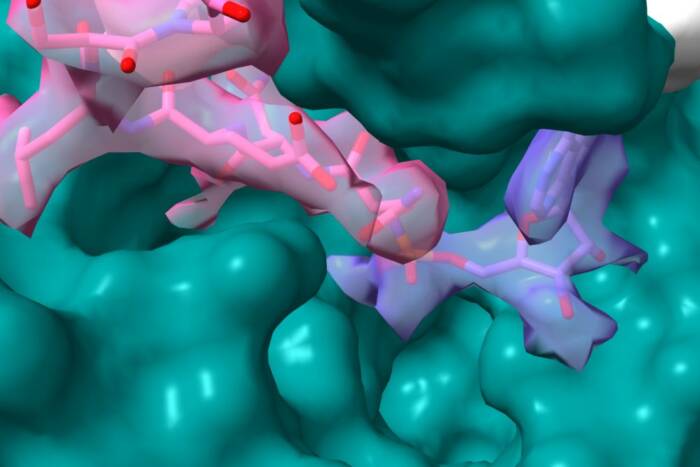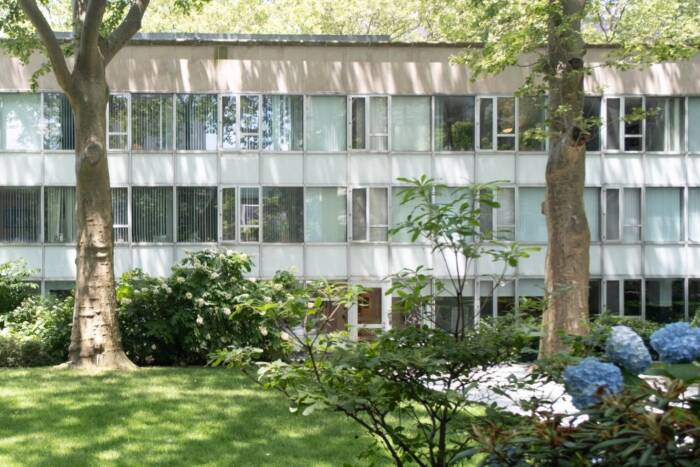Preparing for a safe split
Rockefeller scientists show how cells establish the correct line-up of chromosomes before they divide
As it prepares to divide, a human cell makes exact copies of all of its 46 chromosomes, so that the two daughter cells each can have a complete set of genetic material. The two sets must separate equally, otherwise the new cells end up with the wrong number of chromosomes. Such problems are common in cancer cells, and have been linked to several types of birth defects.
Trying to understand the cause of these problems, Rockefeller University scientist Hironori Funabiki, Ph.D., studies how a dividing cell evenly distributes two sets of chromosomes to its daughter cells.
In the July 23 issue of the journal Cell, Funabiki and his research colleagues report new insights into how cells avoid mistakes when they divide. “It’s a story about how dividing cells ensure that things go right,” says first author of the paper, Srinath Sampath, an M.D.-Ph.D. student in the Laboratory of Chromosome and Cell Biology headed by senior author Funabiki.
The Rockefeller scientists discovered two new proteins that are necessary for building and stabilizing a framework of molecular fibers in the cell, called a spindle. As the cell divides, the chromosome pairs line up across the cell, guided by the spindle. Then the spindle helps pull the pairs apart, so that both daughter cells each receive exactly one copy of each chromosome.
Funabiki and his colleagues also discovered a new chromosome-driven mechanism for spindle attachment, and propose a model for how this process is regulated. Their results help explain a crucial step in cell division, which has remained poorly understood.
Using a powerful technique that Funabiki developed as a postdoctoral fellow at UCSF and Harvard University, he and his Rockefeller coworkers searched for new proteins that are produced at specific stages of cell division. They focused on extracts from egg cells of the African clawed frog Xenopus laevis that were kept in metaphase, the stage of cell division at which spindle-chromosome connections are formed. They identified two new related proteins, which they named Dasra A and Dasra B.
Funabiki says he wants to know if these newly discovered proteins may represent a control mechanism in cancer development
The Dasra proteins also exist in many other species. From database searches, Funabiki and his coworkers identified Dasra A in amphibians, fish and chicken – species in which early embryonic cells divide frequently. By contrast, they found that humans and other mammals, in which embryonic development is slow, appear to produce only Dasra B.
“We speculate that there are different needs in different organisms, and that Dasra A is specifically functioning during rapid embryonic divisions,” says Sampath. Species that reproduce in large numbers, such as animals that lay many eggs in the open, favor rapid development over well-controlled – but slower – cell division. He suggests that Dasra A may be related to the apparently less stringent quality control of cell division in these species.
Funabiki and his coworkers discovered that Dasra A and Dasra B are components of the “chromosomal passenger complex,” an assembly of proteins that bind to chromosomes during metaphase, to help organize chromosomes within the cell as it divides. This discovery led the scientists to study the role of the chromosomal passenger complex in spindle formation.
The spindle consists of microtubule polymers that span the cell and attach to structures called centrosomes, located at opposing ends of a dividing cell. Microtubules normally act like railway tracks in cells, enabling transport of cellular material. During cell division, however, the microtubule networks disassemble, or depolymerize, and reassemble to form the spindle framework.
During metaphase, a chromosome pair usually appears as a characteristic X-shaped structure, held together at the “waist,” or centromere. Funabiki and his team studied a laboratory system, which contained neither centromeres nor the centrosomes that anchor the spindle framework. They demonstrated that the chromosomal passenger complex is necessary for spindle assembly in these chromosomes. They also showed that the passenger complex regulates the activity of a protein that depolymerizes microtubules, called MCAK (mitotic centromere-associated kinesin).
In their Cell paper, Funabiki and his colleagues propose that the chromosomal passenger complex inhibits the microtubule-degrading activity of MCAK around spindle-attachment points. Inactivation of MCAK thus permits microtubules to polymerize and to form stable connections with the chromosomes.
The chromosomal passenger complex contains a protein called Aurora B. This protein is thought to play a role in the control of microtubule stability around centromeres. Funabiki and his coworkers present new evidence that Aurora B is also a key player in regulating spindle growth around the “arms” of chromosomes. It is possible, Sampath says, that the cell-cycle control activity of Aurora B is in turn regulated by the Dasra proteins.
Organisms that reproduce sexually use two schemes for cell division. Somatic cells divide through mitosis, whereas germ cells – sperm and egg cells – undergo meiosis. “We’re working at the boundary of mitosis and meiosis,” says Funabiki, referring to the frog-egg extract system used in his laboratory. “Working in the border zone you may find principles that apply to both,” adds Sampath.
While these new results from the Rockefeller scientists may give fundamental insights into mitotic cell division, they apply directly to meiosis in egg cells. Egg cells do not have centrosomes, and initiate spindle assembly with the arm portions of their chromosomes. Interestingly, compared with sperm cells, which have centrosomes, meiosis in egg cells is more likely to produce cells with incorrect numbers of chromosomes.
“We want to understand the principles underlying accurate chromosome segregation,” Sampath says. Incorrect segregation of chromosomes in germ cells may be the cause of some birth defects. Down’s syndrome, for example, is characterized by the presence of an extra chromosome although, Funabiki notes, the exact cause of this condition is not yet known.
Also involved in the study were Oliver Leisman, Ph.D., postdoctoral researcher in Funabiki’s group, Ryoma Ohi, Ph.D., and Adrian Salic, Ph.D., at Harvard Medical School, and Andrei Pozniakovski, Ph.D., at the Max Planck Institute of Molecular Cell Biology and Genetics in Dresden, Germany.
The work was supported by a grant from the National Institutes of Health Medical Scientist Training Program to Sampath; a Searle Scholarship to Funabiki; a fellowship from the European Molecular Biology Organization to Leismann; the Alexandrine and Alexander Sinsheimer Fund; and the Irma T. Hircshl and Monique Weill-Caulier Trust.


